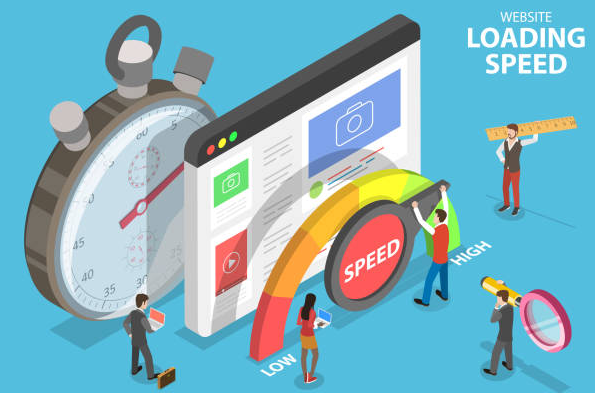Need for Speed: Effective Strategies to Optimize Website Performance and Loading Speed

A website not loading quickly may lead increase in bounce rates as chances are high for a visitor to drop off and visit your competitor’s website built by website design agencies in Dubai.
The website should load quickly to increase its digital footfall and retain visitors for a longer time on the website. Various research has concluded that a delay of a few seconds can have a huge impact on lead generation and conversion rates. Enterprises must optimize websites for their performance.
In this article, we will shed light on how your website loading speed and performance can be optimized and make sure to give a smooth and quick user experience to website visitors. Let’s deep dive into different ways your website can load faster.
Read Also: 9 Tips for a Successful Company Website
1. Minimize HTTP Requests
Reducing the number of HTTP requests made by a web page is crucial for improving loading speed. Combine multiple CSS and JavaScript files into smaller versions to reduce the number of requests.
Compress images and visuals to reduce their file sizes without compromising on their quality. Consider utilizing CSS sprites, which combine multiple images into a single file, and use CSS positioning to display them selectively. By minimizing HTTP requests, you decrease the load on the server and enable faster rendering of web pages.
2. Enable Browser Caching
Browser caching enables a web page to store users’ information or preferences. By doing so, it does not require information or preferences again from the user. You can enable caching for static resources like images, CSS, and JavaScript files by setting up cache headers.
If a visitor visits the websites more frequently, they may not need to enter the details again and again, making the website visit fast and smooth. Browser caching significantly improves the loading speed and overall performance of your website.
3. Optimize Code and Script Files
Clean and optimized code plays a crucial role in website performance. You can reduce CSS, JavaScript, and HTML files by removing unwanted white spaces, comments, and line breaks with the help of a website design company. Combine them with multiple script files into a single file.
This will help in decreasing the number of requests. You can also use simultaneous loading of non-critical JavaScript files to prevent them from blocking the rendering of the page.
Additionally, consider deferring the loading of non-essential scripts until after the page has finished rendering. These optimization techniques enhance the efficiency of code execution and contribute to faster website performance.
4. Compress and Optimize Images
Images are heavy in size and hence, often account for a significant portion of a web page’s file size. Compressing and optimizing images can greatly reduce loading times. Use image compression tools to decrease file size without compromising the visual quality of the images.
Convert images to the appropriate file format (JPEG for photographs, PNG for graphics with transparency) to minimize file sizes.
Additionally, implements lazy loading, which defers the loading of images that are below the fold or not immediately visible to the user. By optimizing images, you can significantly improve the loading speed and user experience.
Read Also: 7 Essential Tips for Google Ads Optimization
5. Use Content Delivery Networks (CDNs)
Content Delivery Networks (CDNs) store cached versions of your website’s static files on multiple servers worldwide. When a user visits your website, the CDN serves the files from the server closest to their location, reducing latency and speeding up content delivery.
Implementing a CDN ensures faster loading times for users regardless of their geographical location. CDNs also offload server resources, allowing your website to handle more concurrent users without sacrificing performance.
6. Monitor and Optimize Server Performance
The performance of your website is closely tied to the performance of your hosting server. Choose a reliable hosting provider that offers optimized server configurations and efficient resource management.
Regularly monitor server response times, uptime, and resource usage to identify any bottlenecks or performance issues. Implement caching mechanisms, server-level optimization techniques, and content compression to maximize server performance. A well-optimized server ensures a fast and consistent loading speed for your website.
7. Continuous Performance Testing and Optimization
Website performance optimization is an ongoing process. Regularly conduct performance testing to identify areas for improvement and monitor the impact of optimizations. Use tools like Google PageSpeed Insights, GTmetrix, or WebPageTest to analyze your website’s performance and receive actionable recommendations.
Optimize critical rendering paths, eliminate render-blocking resources, and fine-tune performance bottlenecks. Continuously review and update your optimization strategies as new technologies and best practices emerge. By prioritizing continuous performance testing and optimization, you ensure that your website maintains optimal speed and performance over time.
Conclusion
In an era where speed is paramount, optimizing website performance with the help of website design agencies in Dubai and loading speed has become essential for success. By implementing the effective strategies mentioned above, you can ensure your website delivers a fast and efficient user experience.
Remember, a lightning-fast website not only delights users but also improves search engine rankings, boosts conversions, and enhances your online reputation. So, prioritize website performance optimization and let your website shine with speed and excellence in the digital realm.







